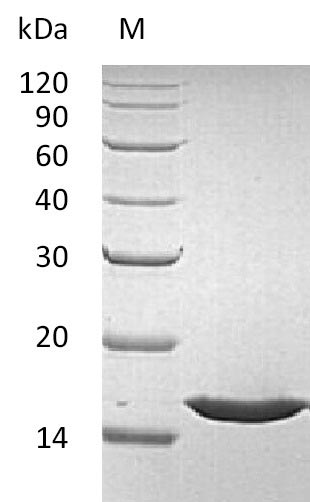FGF-1 (human) (rec.) (untagged)
AG-40B-0137
Protein IDP05230
Product group Proteins / Signaling Molecules
Overview
- SupplierAdipoGen Life Sciences
- Product NameFGF-1 (human) (rec.) (untagged)
- Delivery Days Customer10
- CertificationResearch Use Only
- Concentration0.1 mg/ml
- Estimated Purity>95%
- Protein IDP05230
- Protein NameFibroblast growth factor 1
- Scientific DescriptionFibroblast growth factors (FGFs) constitute a family of heparin-binding polypeptides involved in the regulation of biological responses such as growth, differentiation and angiogenesis. The biological effects of FGFs are mediated by four structurally related receptor tyrosine kinases denoted FGFR1, FGFR2, FGFR3 and FGFR4. FGF-1 [FGF-acidic; ECGF; HBGF-1] is a powerful mitogen of cells of mesodermal, ectodermal and endodermal origin. FGF-1 association with heparan sulfate is a prerequisite for activation of FGF receptors. FGF-1 plays a role in various stages of development and morphogenesis as well as in angiogenesis and wound healing processes. Recent data indicate a role of FGF-1 in inflammation and obesity. FGF-1 is selectively induced in fat cells by high-fat diet feeding and established the PPARgamma-FGF-1 axis as a critical pathway that regulates adipose tissue remodeling. - Protein. Human FGF-1 (aa 16-155) is untagged. Source: E. coli. Endotoxin content: 95% (SDS-PAGE). Fibroblast growth factors (FGFs) constitute a family of heparin-binding polypeptides involved in the regulation of biological responses such as growth, differentiation and angiogenesis. The biological effects of FGFs are mediated by four structurally related receptor tyrosine kinases denoted FGFR1, FGFR2, FGFR3 and FGFR4. FGF-1 is a powerful mitogen of cells of mesodermal, ectodermal and endodermal origin. FGF-1 association with heparan sulfate is a prerequisite for activation of FGF receptors. FGF-1 plays a role in various stages of development and morphogenesis as well as in angiogenesis and wound healing processes. Recent data indicate a role of FGF-1 in inflammation and obesity. FGF-1 is selectively induced in fat cells by high-fat diet feeding and established the PPARgamma-FGF-1 axis as a critical pathway that regulates adipose tissue remodeling.
- Storage Instruction-20°C,2°C to 8°C
- UNSPSC12352202






